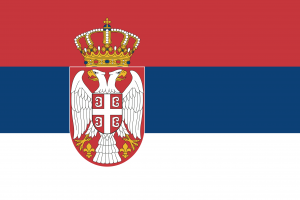Language/Serbian/Vocabulary/Clothes-and-Accessories
 Հայերէն
Հայերէն Български език
Български език 官话
官话 官話
官話 Hrvatski jezik
Hrvatski jezik Český jazyk
Český jazyk Nederlands
Nederlands English
English Suomen kieli
Suomen kieli Français
Français Deutsch
Deutsch עברית
עברית हिन्दी
हिन्दी Magyar
Magyar Bahasa Indonesia
Bahasa Indonesia فارسی
فارسی Italiano
Italiano 日本語
日本語 Қазақ тілі
Қазақ тілі 한국어
한국어 Lietuvių kalba
Lietuvių kalba Νέα Ελληνικά
Νέα Ελληνικά Şimali Azərbaycanlılar
Şimali Azərbaycanlılar Język polski
Język polski Português
Português Limba Română
Limba Română Русский язык
Русский язык Español
Español العربية القياسية
العربية القياسية Svenska
Svenska Wikang Tagalog
Wikang Tagalog தமிழ்
தமிழ் ภาษาไทย
ภาษาไทย Türkçe
Türkçe Українська мова
Українська мова Urdu
Urdu Tiếng Việt
Tiếng Việt
| ◀️ Verbs: Imperative — Previous Lesson | Next Lesson — At the Market ▶️ |
As a Serbian teacher, I have noticed that one of the most frequent reasons students decide to learn Serbian is their connection to Serbian culture. That's why, in this lesson, I will teach you Serbian vocabulary related to clothes and accessories. This knowledge will come in handy if you plan to visit Serbia or if you want to watch Serbian movies or listen to Serbian music.
Consider broadening your understanding by checking out these related lessons: Cosmetics & Places around Town.
Clothes
Let's start with the Serbian words for clothing items. 'Odeća' is the general term for clothes in Serbian. Don't be fooled by the accents; they make a big difference. Here are some other useful Serbian words for clothes:
| Serbian | Pronunciation | English |
|---|---|---|
| bluza | /bluza/ | blouse |
| džemper | /dʒempɛr/ | sweater |
| farmerke | /farmɛrkɛ/ | jeans |
| haljina | /haljina/ | dress |
| jakna | /jakna/ | jacket |
| kaput | /kaput/ | coat |
| košulja | /kɔʃuja/ | shirt |
| pantalone | /pantalonɛ/ | pants |
| suknja | /suknja/ | skirt |
| šortsevi | /ʃɔrtsɛvi/ | shorts |
As you can see, Serbian words for clothes items are similar to the ones in English. However, you might have noticed that Serbian words have a different plural form, which makes them harder to remember. Have no worries! With practice, you'll master Serbian vocabulary in no time.
Accessories
Accessories are crucial for creating an interesting and unique outfit. 'Dodaci' is the Serbian term for fashion accessories. Here are some words to help you describe your accessories in Serbian:
| Serbian | Pronunciation | English |
|---|---|---|
| cipele | /tsipɛlɛ/ | shoes |
| kaiš | /kaiʃ/ | belt |
| kačket | /katʃkɛt/ | cap |
| kišobran | /kiʃɔbran/ | umbrella |
| marame | /maramɛ/ | scarf |
| naočare za sunce | /naɔtʃarɛ za sʊnʦɛ/ | sunglasses |
| nakit | /nakit/ | jewelry |
| ranac | /ranats/ | backpack |
| rukavice | /rukavitʃɛ/ | gloves |
In addition to the above, I should also tell you that some accessories in Serbian culture are worn for specific reasons. For example, Serbian women traditionally wear 'nošnja' for folk dances. It's a costume made up of different accessories such as a colorful skirt, an embroidered blouse, and a decorative apron. If you ever visit a Serbian folk dance performance, you might find this information helpful.
Shopping Phrases
To practice your Serbian vocabulary for clothes and accessories, it's essential to know some basic shopping phrases. Here are some Serbian phrases that will help you when shopping for clothes:
- "Što preporučujete?" - "What do you recommend?"
- "Da li imate ovaj proizvod u drugoj veličini?" - "Do you have this item in another size?"
- "Da li mi možete dati račun?" - "Can you give me the receipt?"
- "Koliko košta?" - "How much is it?"
- "Mogu li platiti karticom?" - "Can I pay with a credit card?"
Make sure to use these phrases when you visit a Serbian clothing store. They will come in handy when you need help from the shopkeeper.
Conclusion
In summary, learning Serbian vocabulary related to clothes and accessories is an essential step in understanding Serbian culture. With this knowledge, you'll be able to describe what you see on the streets, in a store or in a movie. I hope you enjoyed this lesson, and I can't wait to continue teaching you Serbian language and culture.
Sources
- Fun Fashion Vocabulary and Clothes in Serbian, Shoes and ...
- Clothes in Serbian | Pinhok Languages
- Serbian Vocabulary - Serbonika
- Serbian lessons: Clothing
Now that you've completed this lesson, don't stop learning! Check out these related topics: Family members & Bathroom.
Other Lessons
| ◀️ Verbs: Imperative — Previous Lesson | Next Lesson — At the Market ▶️ |

